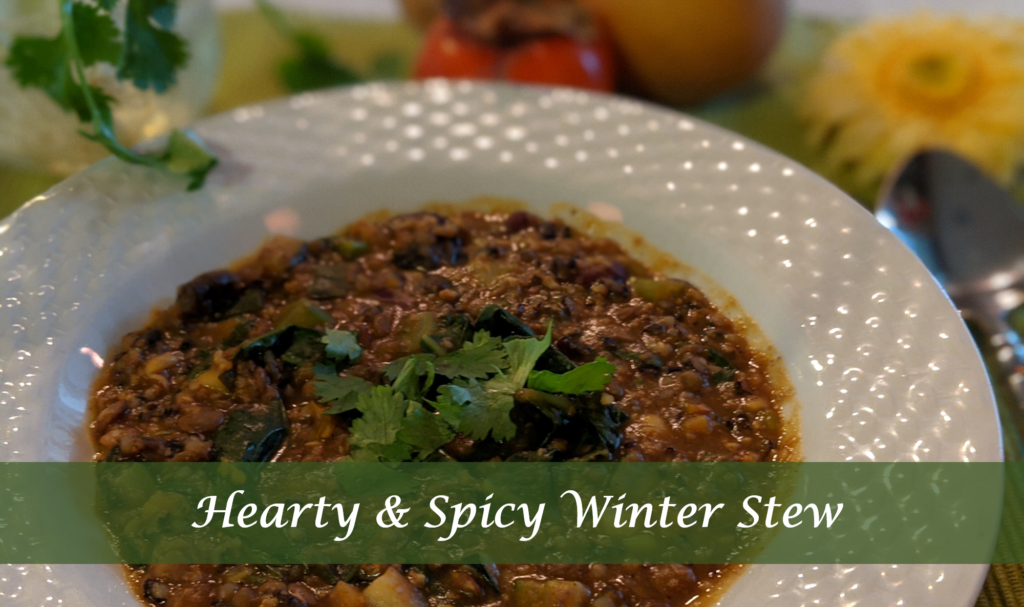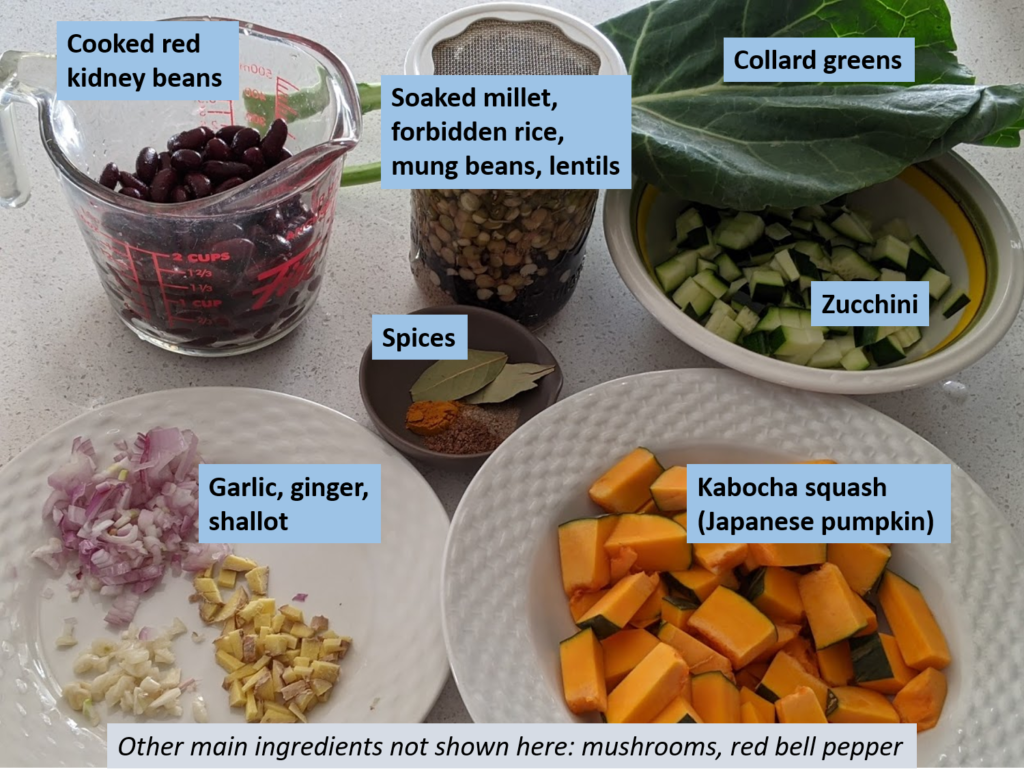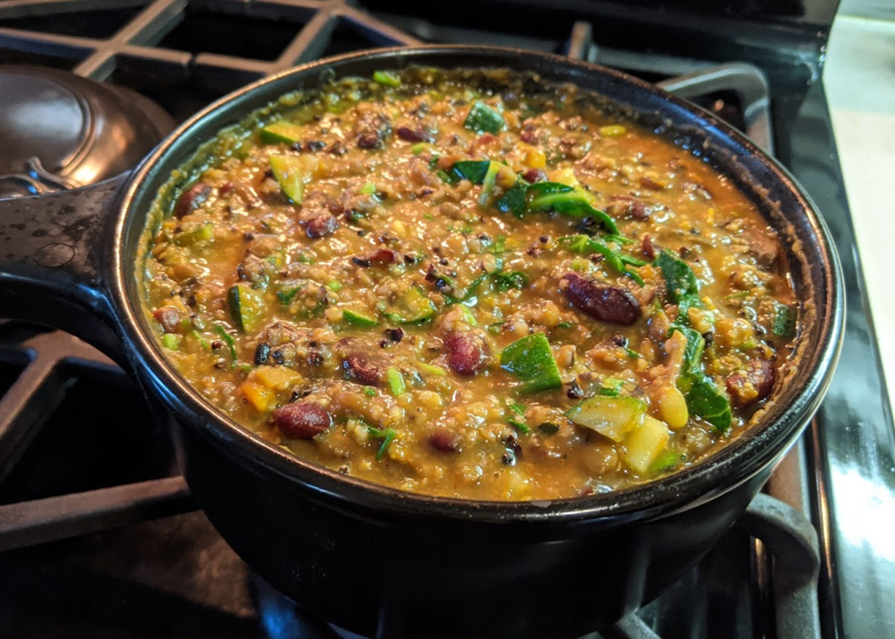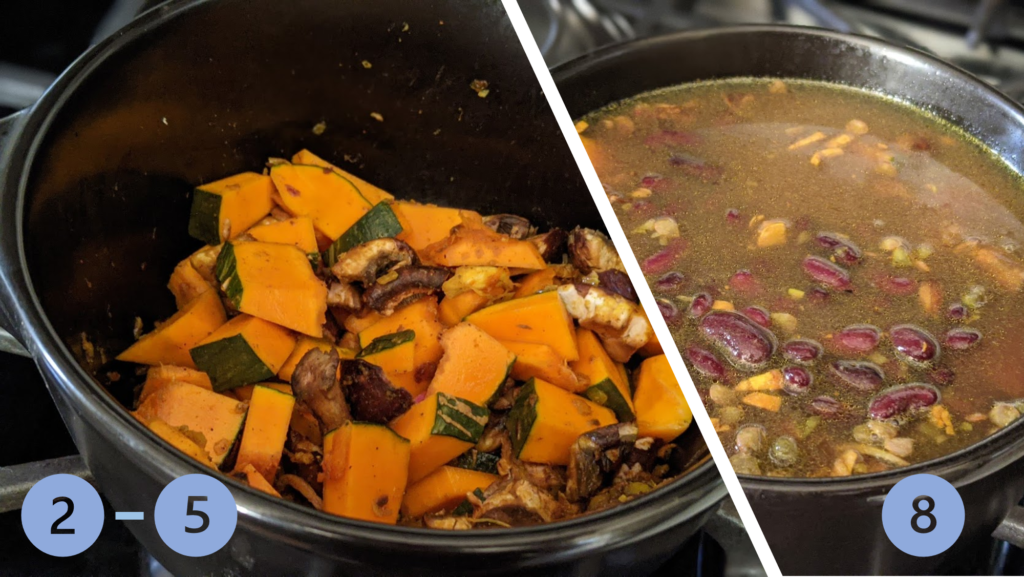Join our mailing list to receive the latest health tips and updates.
You have Successfully Subscribed!
Eat to Live – Hearty & Spicy Winter Stew

Happy New Year!
In this new year, you may have made a new year resolution to empower yourself and take charge of your health by eating healthy and adopting a healthy lifestyle, so that you can thrive, enjoy and live your life to the fullest.
Numerous scientific studies have shown the health benefits of a whole-food plant-rich diet in strengthening our immune system and reducing the risks of many chronic diseases including type-2 diabetes, hypertension, heart disease, cancer, Alzheimer’s disease/dementia, chronic liver disease, etc.
A whole-food plant-rich diet is rich in fibers, antioxidants and many health-promoting micronutrients and phytonutrients. Such a diet consists of plenty and a large variety of whole fruits and vegetables of a wide variety of colors, moderate amount of legumes and whole grains, and low-to-moderate amount of healthy fats from nuts, seeds, avocado, olive, etc.
For more information and the relevant scientific research references, please check out my previous articles:
Simple Guidelines for Healthy Eating
How to Support Your Immune Health – See What Scientific Research Showed
In this blog, I share a delicious, hearty and warming winter stew recipe that is made with whole-food ingredients and rich in antioxidants, anti-inflammatory properties and other health-promoting compounds. For a quick glance of the recipe, you can go directly to the Recipe section.
For more healthy and delicious recipe ideas, you can check out my previous blogs:
Easy and Delicious Ways to Add Fruits and Vegetables to Your Diet
Homemade Coconut Yogurt – A Treat for Yourself and Your Gut Microbiota
Enjoy!
Ingredients

There are 4 main groups of ingredients as described below that you can mix and match. In this recipe, I chose ingredients that cover a wide variety of colors (which correspond to diverse health-promoting phytonutrients – or plant nutrients), i.e., red, orange, yellow, green, and purplish black.
Fill free to experiment and be creative!
Use organic ingredients whenever possible to reduce toxin exposure.
Winter Squash
This is now the season to consume some nutritious winter squash.
Winter squash such as pumpkin, kabocha, acorn, butternut, etc. are low in glycemic index and rich in fibers, antioxidants, minerals and other health-promoting properties (e.g., cancer-fighting properties, support of gut and digestive health, immune health, blood glucose regulation, etc.).1–4
I use kabocha squash (also called Japanese pumpkin) in this recipe. Feel free to choose your preferred winter squash or use a variety of winter squash.
Leafy Greens and Other Vegetables
Leafy greens are rich in fibers, vitamins, minerals, antioxidants and many health-promoting compounds that help to combat many chronic diseases and support the body’s detoxification.5,6
I use collard greens in this recipe. Feel free to use other leafy greens such as kale, spinach, etc.
You can also add in other crunchier vegetables such as celery, zucchini, for taste and texture. I use zucchini in this recipe.
Legumes
Legumes are high in fibers, protein, vitamins and minerals and are also good sources of antioxidants. Regular consumption of legumes has been found to be associated with reduced risks of heart disease, hypertension, type-2 diabetes, obesity and cancer.7–9
In this recipe, I use green lentils, mung beans and red kidney beans. You can mix and match 2 to 3 types of beans of your choice.
You can use either dried beans or cooked beans. If dried beans are used, soak the beans overnight or for at least 7-8 hours to reduce the antinutrients (incl. phytic acid and lectins) for better digestion and nutrient absorption.
Whole Grains
As opposed to refined grains (e.g., while rice, white flour) which are stripped off nutrients and fibers, whole grains are rich in minerals, vitamins, fibers and health-promoting phytonutrients including antioxidants.5,6
Studies have shown that diets rich in whole grains are associated with reduced levels of inflammation and LDL (bad) cholesterol, and reduced risks of chronic diseases including heart disease, hypertension, and type-2 diabetes, obesity, and cancer.7,8
I use two types of gluten-free whole grains in this recipe, i.e., millet and black rice (also known as forbidden rice or purple rice). Black rice is an ancient grain eaten in regions of Asia for thousands of years. Black rice is rich in antioxidants and has one of the highest levels of the potent antioxidant, anthocyanins, which give it a purplish black color.10 Anthocyanins have been shown to have anti-diabetic, anti-cancer, anti-obesity, anti-inflammatory, LDL (or bad) cholesterol lowering, and brain protection effects.11
You can use other types of gluten-free and nutrient-rich whole grains such as quinoa, amaranth, buckwheat, wild rice, etc.
Soak the whole grains together with the dried beans (if dried beans are used) overnight for at least 7-8 hours, for better digestion and increased nutrient absorption.
Other Ingredients, Spices
The following ingredients can add more depth to the flavor of the stew as well as enhancing the nutritional content.
Red Bell Pepper or Tomato
Both red bell pepper and tomato are antioxidant-rich foods. Tomato is one of the best sources of lycopene, an antioxidant known for its anti-cancer properties.12 Red bell pepper contains high levels of lutein and zeaxanthin, antioxidants known to support healthy eyes and vision.13
Adding either red bell pepper or tomato or both into the stew can create more depth and umami flavor in the stew.
Mushrooms
Mushrooms also have many health-promoting properties including support of cognition, weight management, oral health and immune health, and reduction of cancer risk.14
Mushrooms have distinct umami flavor and can really enhance the overall flavor of the stew. Use your preferred mushrooms for the stew. In this recipe, I used shitake and cremini mushrooms.
Spices and Condiments
Spices not only enhance the flavor of our foods but they also have many health-promoting and therapeutic properties including anti-inflammatory, anti-oxidant, anti-cancer, and anti-microbial properties.15–18 Curcumin, an active compound found in turmeric, is one of the most well researched spices for human health and many health benefits have been shown including support of heart health, immune health, cognitive health, etc.15,16
The spices used in this recipe are turmeric, cardamom, garam masala and coriander.
Other ingredients that further enhance the flavor of the stew are garlic and shallot (can also use red onion). Strictly speaking, these are not spices. They belong to the allium family of vegetables and have been shown to exhibit anti-cancer, anti-inflammatory, antioxidant, anti-infection, lipid and cholesterol lowering, and heart and liver protective properties.19–21
Use Celtic or Himalayan sea salt as they are rich in minerals.
Recipe

(Servings: 3-4 as main course, or 7-8 as side dish)
Prep time: 20 minutes
Cook time: 1 hour (may need more time depending on cooking time of your chosen beans)
Total time: 1 hour 20 minutes (may need more time depending on cooking time of your chosen beans)
Ingredients
- Pumpkin (or other winter squash): 2 cups (cut into large cubes)
- Whole grains: ½ cup (uncooked)
- Used in this recipe: ¼ cup millet + ¼ cup forbidden rice
- Legumes: 1 cup dried beans or 2 cups cooked beans or a mixture of dried and cooked beans (see tips below)
- Used in this recipe: ¼ cup dried green lentils + ¼ cup dried mung bean + 1 cup cooked red kidney beans
- Zucchini: 1 medium size (diced)
- Leafy greens (e.g., kale, collared green, swiss chard): 1½ cup (chopped, separate stems from leaves)
- Mushrooms: 1 cup (diced)
- Used in this recipe: cremini + shitake
- Optional:
- Tomatoes: 2 medium size (pureed); or
- Red bell pepper: 1 medium size (pureed)
- Garlic: 2 cloves (finely chopped)
- Ginger: 1 inch (finely chopped)
- Shallot: 1 medium size (or 1 small red onion) (finely chopped)
- Spices:
- Ground cumin: ¼ tsp
- Ground cardamom: ¼ tsp
- Ground turmeric: ¼ tsp
- Garam masala: ¼ tsp
- Bay leaves: 2
- Optional: pinch of cayenne pepper
- Lemon juice: 3 Tbsp or to taste
- Sea salt: 1 tsp or to taste
- Water or stock: 4 cups (adjust based on preferred thickness of stew)
- Avocado oil or other cooking oil (see tips below)
- Chopped coriander for garnish
Instructions
(See also tips and photos below)
- Soak grains and dried beans overnight (or for at least 8 hours). Drain, rinse, and set it aside.
- Heat stock pot over medium heat, add 1 Tbsp of avocado oil.
- Sauté garlic, shallot and ginger until fragrance.
- Reduce heat to low, then add all the spices except bay leaves. Sauté for about 5 minutes.
- Turn heat to medium and add pumpkin and mushrooms. Sauté for about 3 minutes.
- Add pureed tomatoes or red bell pepper. Sauté for another 2 minutes.
- Add water/stock and bay leaves. Cover and set to medium-high heat to bring to boil.
- Once boiled, add all the grains and beans.
- Bring to boil again and keep at medium to high heat to boil for 3 minutes (keep the pot uncovered or partially covered to avoid spill over).
- Reduce heat to low and simmer with lid covered, for 30 minutes or more until beans become slightly tender (Note: Large beans may need an hour or more to become tender).
- Add zucchini and stems of leafy greens. Simmer for 10 minutes.
- Add leaves of leafy greens and simmer for another 5 minutes.
- Add salt to taste.
- Turn off heat and add lemon juice to taste.
- Add chopped coriander before serving.
Tips
- Feel free to experiment with your preferred choices of whole grains and beans.
- For beans, you can used either dried or cooked beans or a mixture of both. 1 cup of dried beans is roughly equivalent to 2 – 2.5 cups of cooked beans. In this recipe, I used ½ cup of dried beans which is equivalent to about 1 cup of cooked beans. In addition, I used 1 cup of cooked beans. Therefore, in this recipe, a total of about 2 cups of cooked beans are used.
- Instead of zucchini, you can also use other crunchier vegetables, e.g., celery.
- Feel free to choose your preferred types of mushrooms.
- To puree tomatoes or red bell pepper, you can use a blender.
- I use avocado oil as it is one of the best cooking oils containing healthy mono- and poly-unsaturated fats, and antioxidant and anti-inflammatory properties, as well as high smoke point.22
- If you serve this stew as a main course, you can pair it with a light, refreshing salad.

Related Articles
Simple Guidelines for Healthy Eating
How to Support Your Immune Health – See What Scientific Research Showed
Easy and Delicious Ways to Add Fruits and Vegetables to Your Diet
Homemade Coconut Yogurt – A Treat for Yourself and Your Gut Microbiota
References
- Kulczyński B, Gramza-Michałowska A. The Profile of Secondary Metabolites and Other Bioactive Compounds in Cucurbita pepo and Cucurbita moschataPumpkin Cultivars. Molecules. 2019;24(16):2945. Published 2019 Aug 14. doi:10.3390/molecules24162945
- Kim HY, Nam SY, Yang SY, Kim HM, Jeong HJ. Cucurbita moschata Duch. and its active component, β-carotene effectively promote the immune responses through the activation of splenocytes and macrophages. Immunopharmacol Immunotoxicol. 2016 Oct;38(5):319-26. doi: 10.1080/08923973.2016.1202960. Epub 2016 Jun 29. PMID: 27315229.
- Divisi D, Di Tommaso S, Salvemini S, Garramone M, Crisci R. Diet and cancer. Acta Biomed. 2006 Aug;77(2):118-23. PMID: 17172193.
- Mahmoodpoor A, Medghalchi M, Nazemiyeh H, Asgharian P, Shadvar K, Hamishehkar H. Effect of Cucurbita Maxima on Control of Blood Glucose in Diabetic Critically Ill Patients. Adv Pharm Bull. 2018;8(2):347-351. doi:10.15171/apb.2018.040
- Morris MC, Wang Y, Barnes LL, Bennett DA, Dawson-Hughes B, Booth SL. Nutrients and bioactives in green leafy vegetables and cognitive decline: Prospective study. Neurology. 2018;90(3):e214-e222. doi:10.1212/WNL.0000000000004815
- Aune D, Giovannucci E, Boffetta P, et al. Fruit and vegetable intake and the risk of cardiovascular disease, total cancer and all-cause mortality-a systematic review and dose-response meta-analysis of prospective studies. Int J Epidemiol. 2017;46(3):1029-1056. doi:10.1093/ije/dyw319
- Becerra-Tomás N, Papandreou C, Salas-Salvadó J. Legume Consumption and Cardiometabolic Health. Adv Nutr. 2019 Nov 1;10(Suppl_4):S437-S450. doi: 10.1093/advances/nmz003. PMID: 31728491; PMCID: PMC6855964.
- Papandreou C, Becerra-Tomás N, Bulló M, Martínez-González MÁ, Corella D, Estruch R, Ros E, Arós F, Schroder H, Fitó M, Serra-Majem L, Lapetra J, Fiol M, Ruiz-Canela M, Sorli JV, Salas-Salvadó J. Legume consumption and risk of all-cause, cardiovascular, and cancer mortality in the PREDIMED study. Clin Nutr. 2019 Feb;38(1):348-356. doi: 10.1016/j.clnu.2017.12.019. Epub 2018 Jan 9. PMID: 29352655.
- Viguiliouk E, Glenn AJ, Nishi SK, et al. Associations between Dietary Pulses Alone or with Other Legumes and Cardiometabolic Disease Outcomes: An Umbrella Review and Updated Systematic Review and Meta-analysis of Prospective Cohort Studies. Adv Nutr. 2019;10(Suppl_4):S308-S319. doi:10.1093/advances/nmz113
- Ghasemzadeh A, Karbalaii MT, Jaafar HZE, Rahmat A. Phytochemical constituents, antioxidant activity, and antiproliferative properties of black, red, and brown rice bran. Chem Cent J. 2018;12(1):17. Published 2018 Feb 17. doi:10.1186/s13065-018-0382-9
- Khoo HE, Azlan A, Tang ST, Lim SM. Anthocyanidins and anthocyanins: colored pigments as food, pharmaceutical ingredients, and the potential health benefits. Food Nutr Res. 2017;61(1):1361779. Published 2017 Aug 13. doi:10.1080/16546628.2017.1361779
- Chen P, Zhang W, Wang X, et al. Lycopene and Risk of Prostate Cancer: A Systematic Review and Meta-Analysis. Medicine (Baltimore). 2015;94(33):e1260. doi:10.1097/MD.0000000000001260
- Wu J, Cho E, Willett WC, Sastry SM, Schaumberg DA. Intakes of Lutein, Zeaxanthin, and Other Carotenoids and Age-Related Macular Degeneration During 2 Decades of Prospective Follow-up. JAMA Ophthalmol. 2015;133(12):1415-1424. doi:10.1001/jamaophthalmol.2015.3590
- Feeney MJ, Dwyer J, Hasler-Lewis CM, et al. Mushrooms and Health Summit proceedings. J Nutr. 2014;144(7):1128S-36S. doi:10.3945/jn.114.190728
- Rakhi NK, Tuwani R, Mukherjee J, Bagler G. Data-driven analysis of biomedical literature suggests broad-spectrum benefits of culinary herbs and spices. PLoS One. 2018;13(5):e0198030. Published 2018 May 29. doi:10.1371/journal.pone.0198030
- Moghadamtousi SZ, Kadir HA, Hassandarvish P, Tajik H, Abubakar S, Zandi K. A review on antibacterial, antiviral, and antifungal activity of curcumin. Biomed Res Int. 2014;2014:186864. doi:10.1155/2014/186864
- D’Souza SP, Chavannavar SV, Kanchanashri B, Niveditha SB. Pharmaceutical Perspectives of Spices and Condiments as Alternative Antimicrobial Remedy. J Evid Based Complementary Altern Med. 2017;22(4):1002–1010. doi:10.1177/2156587217703214
- Vázquez-Fresno R, Rosana ARR, Sajed T, Onookome-Okome T, Wishart NA, Wishart DS. Herbs and Spices- Biomarkers of Intake Based on Human Intervention Studies – A Systematic Review. Genes Nutr. 2019;14:18. Published 2019 May 22. doi:10.1186/s12263-019-0636-8
- Antony ML, Singh SV. Molecular mechanisms and targets of cancer chemoprevention by garlic-derived bioactive compound diallyl trisulfide. Indian J Exp Biol. 2011;49(11):805–816.
- Tapiero H, Townsend DM, Tew KD. Organosulfur compounds from alliaceae in the prevention of human pathologies. Biomed Pharmacother. 2004;58(3):183–193. doi:10.1016/j.biopha.2004.01.004
- Mikaili P, Maadirad S, Moloudizargari M, Aghajanshakeri S, Sarahroodi S. Therapeutic uses and pharmacological properties of garlic, shallot, and their biologically active compounds. Iran J Basic Med Sci. 2013;16(10):1031–1048.
- Bhuyan DJ, Alsherbiny MA, Perera S, et al. The Odyssey of Bioactive Compounds in Avocado (Persea americana) and Their Health Benefits. Antioxidants (Basel). 2019;8(10):426. Published 2019 Sep 24. doi:10.3390/antiox8100426
